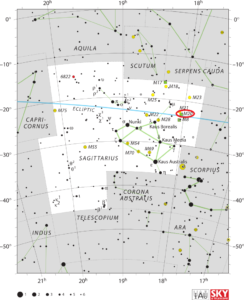Messier 20, the Trifid Nebula, is an Open Cluster as well as a combination of Emission, Reflection and Dark Nebula located in the Sagittarius region of the Milky Way. It also belongs to the constellation Sagittarius. M20 gets the name Trifid Nebula from the fact that the dark nebula divides its appearance into 3 separate lobes. In most images, the emission nebula area shows up red while the reflection nebula appears blue.
| Description | |
| Visible From Pacific Northwest | April Through August |
| Best Time To Observe | August |
| Minimum Size Of Viewing Device | Small Telescope |
| Object Type | Emission, reflection, or dark Nebula with an open cluster |
| Designations | Messier 20, M20, Trifid Nebula, NGC 6514, Sharpless 30, RCW 147, Gum 76, C 1759-230, Collinder 360, LBN 27, MWSC 2789, OCl 23.0 |
| Right Ascension | 18h 02m 23s |
| Declination | -23°01’48” |
| Constellation | Sagittarius |
| Age | 300,000 years |
| Apparent magnitude | +6.3 |
| Apparent dimensions | 28′ |
| Object Radius | 21 light years |
| Distance From Earth | 5,200 light years |
History
Charles Messier discovered the nebula on June 5, 1764 and described it as a “cluster of stars, a little above the Ecliptic, between the bow of Sagittarius & the right foot of Ophiuchus.”
William Herschel observed M20 on July 12, 1784 and noted that “three nebulae, faintly joined, form a triangle. In the middle is a double st[ar], vF [very faint], and of great extent.” When Herschel catalogued M20, he assigned the object four different numbers: H IV.41 (added on May 26, 1786) and H V.10, H V.11 and H V.12 (added on July 12, 1784.)
John Herschel viewed the object on July 1, 1826 and was the first to call it Trifid. He noted, “vL [very large]; trifid, three nebulae with a vacuity in the midst, in which is centrally situated the double star Sh 379, neb == 7′ in extent. A most remarkable object.”
Edward Emerson Barnard catalogued the dark nebula in M20 as Barnard 85, which appeared on the list of Barnard objects in the first Barnard Catalogue of Dark Markings in the Sky, published in 1919.
Locating M20 In The Sky
The Trifid Nebula can be found about 2 degrees to the northwest of the larger and brighter Messier 8 the Lagoon Nebula and appears in the same field of view as the open cluster Messier 21. M20 can be located in the same way as the Lagoon, using the Teapot asterism in Sagittarius. It lies a few degrees to the west of Lambda Sagittarii, the star at the top of the Teapot. The larger Lagoon Nebula is visible to the naked eye on clear, moonless nights and the Trifid appears as a hazy patch of light only 2 degrees away.

Viewing M20
M20 is a fine sight in 7×50 or 10×50 binoculars, appearing as fuzzy circular diffuse shape. A small 80mm (3.1-inch) telescope hints at dark lanes spreading from the center of the nebula, especially when viewed under dark skies. With a 150mm (6-inch) or 200mm (8-inch) scope, the Trifid becomes an exciting object. Its irregular shape is visible, along with the trisecting dark lanes, exquisite twists/turns and under good conditions hints of colour.
Photographing M20
Photographing the Trifid Nebula is something that is quite popular with many astrophotographers. As it is something that can easily be done with a DSLR and a CMOS camera, it is a very popular target. When photographing the Trifid Nebula, it is recommended to obtain as much time as possible to obtaining photos, which will be about 3 hours. Because it can be low in the southern sky, all the time capturing data will be helpful. 3 minute exposures with an auto guided telescope should be able to provide some great shots!
Sources And Further Reading
Descriptions of all of Messier Objects can be found here.
https://www.nasa.gov/feature/goddard/2017/messier-20-the-trifid-nebula
https://www.galactic-hunter.com/post/__m20

Be the first to comment on "Messier 20 Trifid Nebula"